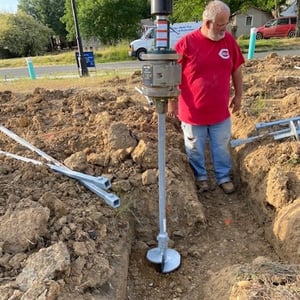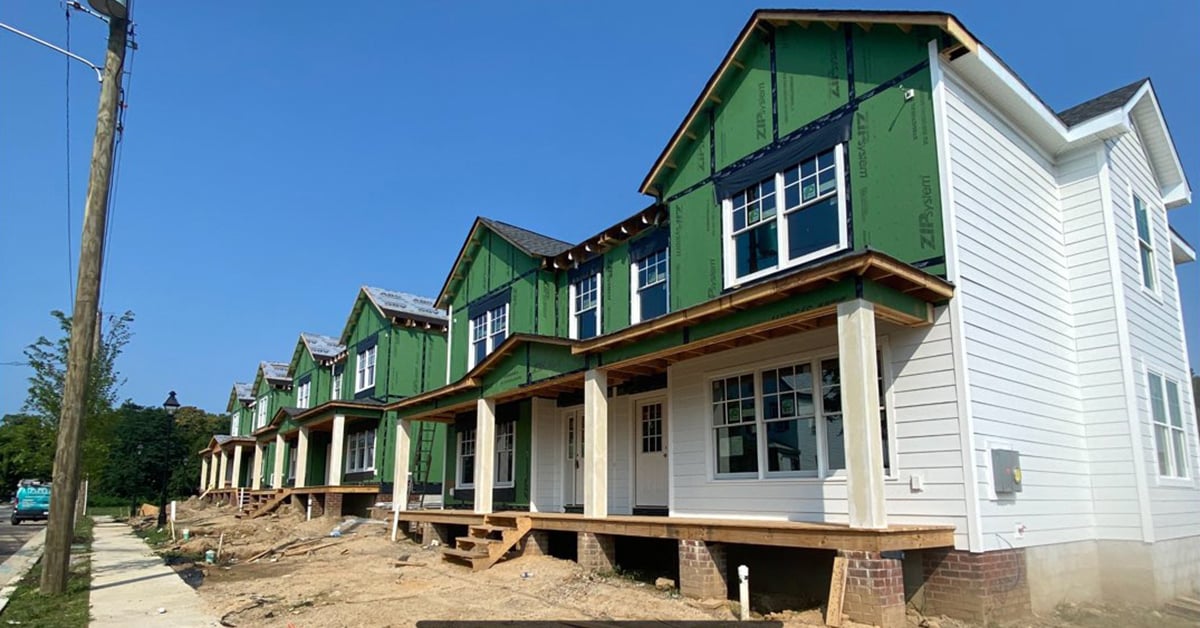The Southside Community Development & Housing Corporation initiated an affordable housing development to build (4) multi-family homes in Richmond, Virginia. Each building was split into approximately (2) 800 sq-ft homes with 3 bedrooms in each home. The corporation hired a local engineering firm to design the project.
Analyzing the Soil
 After the soil subsurface exploration and geotechnical analysis, the engineer recommended the foundations use helical piles to support the new buildings. Based on the Geotechnical Report, the soil had a moderate-high shrink swell potential with a high moisture content. If a shallow foundation is constructed on shrink-swell soil in a wet year, it would likely settle during a dry (shrink) year. Installing helical piles deep into competent, load-bearing soil is an excellent choice because it protects the structure (and its owners) from seasonal soil changes causing shifting and settling.
After the soil subsurface exploration and geotechnical analysis, the engineer recommended the foundations use helical piles to support the new buildings. Based on the Geotechnical Report, the soil had a moderate-high shrink swell potential with a high moisture content. If a shallow foundation is constructed on shrink-swell soil in a wet year, it would likely settle during a dry (shrink) year. Installing helical piles deep into competent, load-bearing soil is an excellent choice because it protects the structure (and its owners) from seasonal soil changes causing shifting and settling.
Helical piles offer installation advantages as well, such as the ability to install in an area with a high-water table.
The owner hired US2bg as the general contractor for the project. Following the recommendations of the engineer, US2bg received multiple estimates on helical piles. Stable Foundations, the local Chance® Certified Installer, was hired to install the square shaft helical piles for the new construction.
What about rock?
Although the soil boring only went 14 feet deep, the experienced installers expected to hit rock around 21 feet, as is common in the Richmond area. A test pile confirmed their predictions.
Therefore, the helical piles consisted of a high-strength Chance Square Shaft Type SS150 ROCK-IT™ lead section. ROCK-IT has a carbide tip on the pilot point below the first helix plate of the lead section, allowing the helical pile to penetrate into even the toughest conditions without field modification or pre-drilling. Each helical pile was torqued into the weathered rock and an SS5 extension was used in conjunction with the SS150 lead section based on the loading conditions to extend the pile to bearing depth.
 Each helical pile was designed to an ultimate capacity of 40 kips. Utilizing the Chance ROCK-IT lead, the capacity of each helical pile was increased to 55 kips per pile due to deeper penetration into the weathered rock. The piles were installed using a Digga 8K drive motor on a Kubota 40 excavator. The Chance helical pile installation tooling string was attached to the excavator’s Kelly bar. Torque was monitored throughout the installation using a Chance digital torque indicator for instant torque-to-capacity correlation. By monitoring torque throughout the installation, the installer can verify capacity calculations that the engineer provided based on the soil profile.
Each helical pile was designed to an ultimate capacity of 40 kips. Utilizing the Chance ROCK-IT lead, the capacity of each helical pile was increased to 55 kips per pile due to deeper penetration into the weathered rock. The piles were installed using a Digga 8K drive motor on a Kubota 40 excavator. The Chance helical pile installation tooling string was attached to the excavator’s Kelly bar. Torque was monitored throughout the installation using a Chance digital torque indicator for instant torque-to-capacity correlation. By monitoring torque throughout the installation, the installer can verify capacity calculations that the engineer provided based on the soil profile.
👉 For more in depth reading on this topic, check out Origin and Development of the Torque Correlation (Kt) Factor.
Each of the three buildings was built on a foundation of (41) helical piles for a total of (123) helical piles for the entire project. Each helical pile was installed to an embedment depth of 21-feet . The helical piles were installed in 5 days averaging 24 piles per day.
If you would like to learn more about the possibilities for helical piles in your area, reach out to your local Chance distributor.


